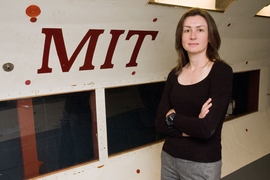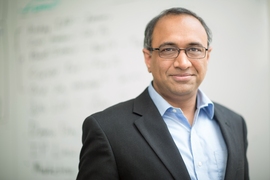A new MIT report on online education policy draws on diverse fields, from socioeconomics to cognitive science, to analyze the current state of higher education and consider how advances in learning science and online technology might shape its future.
The report was led by Sanjay Sarma, professor of mechanical engineering and vice president for open learning, and Karen Willcox, professor of aeronautics and astronautics. The analysis comes out of the MIT Online Education Policy Initiative, which is co-chaired by Sarma and Willcox, composed of a core working group of MIT faculty and researchers, and advised by an external advisory board of experts from academic, nonprofit, and policy sectors.
Titled “Online Education: A Catalyst for Higher Education Reform,” the report presents four overarching recommendations, stressing the importance of interdisciplinary collaboration, integration between online and traditional learning, a skilled workforce specializing in digital learning design, and high-level institutional and organizational change.
“We hope that this work will help to give our point of view on how university professors, policy makers, and government officials can think about technology and online education in the context of education at large,” says Sarma, who is the Fred Fort Flowers and Daniel Fort Flowers Professor in Mechanical Engineering at MIT.
The analysis covers — among other forms of digital learning — Massive Open Online Courses (MOOCs) such as those on edX, which provide free courses to millions of people around the world.
“Online education has existed for a long time, but this form of automatic tutoring that is the backbone of MOOCs enables interactivity at a scale that is unprecedented,” says Sarma.
The authors brought to bear educational research findings from a variety of disciplines while taking stock of digital learning.
"There's so much going on in online education, and it's moving so quickly, that it's important to take time to reflect," says Eric Klopfer, a key participant in the initiative, who is a professor of education and directs the MIT Scheller Teacher Education Program.
“One of the goals of the report is to try to help frame the discussion and to pull together some of the pieces of the conversation that are taking place in different arenas but are not necessarily considered in an integrated way,” Willcox says.
Integrating research
The report calls for interdisciplinary collaboration among experts in fields that may not have had strong links historically but can all impact learning: social scientists, education experts, psychologists, and neuroscientists, to name a few.
“There are people in everything from cognitive sciences, to learning sciences, to traditional education technology, to discipline-based education research, as well as disciplinary experts,” Klopfer says. "It's important to be thinking about ways in which all these people interact, for both course creation and understanding what's working in these online courses.”
In many of these fields, learning-related research is advancing rapidly.
“We’re on the very edge of the beginning of an era where neuroscientists, for example, are starting to understand how learning takes place, in a way we never have before,” says Willcox.
“There's a fair bit of research that's already moving forward about ways that we can improve efficiency and improve retention,” says Klopfer. “We can use machine learning to help us get better at those things and help people learn more quickly and more effectively. But the real important innovations are yet to come, as we discover ways of engaging new learners and situating learning to promote deeper understanding.”
Collaborating on learning-related work across disciplines through an integrated research agenda could yield powerful advances in optimizing online learning experiences, the authors reasoned. They considered fields that look “outside in” at education from a larger, descriptive perspective and those that work “inside out” by studying how a specific part of learning functions — and the ways in which this distinction is disappearing.
“Convergence of outside-in and inside-out research approaches has revolutionized fields such as biology and mechanics; we believe that education is on the brink of a similar revolution,” the report states.
Designing the learning experience
One of the biggest questions around online learning is how and where it fits with in-person learning. The report’s second recommendation suggests viewing online capabilities as a scaffold and support rather than a replacement for in-person interactions between teachers and students.
Online learning environments can be used to space learning across longer time periods and improve retention; provide learning opportunities remotely and through games or other media; and give teachers valuable data on students’ areas of challenge and success, the authors note.
“For students who have access, technology should be seen as something that enables a vastly richer range of experiences, such as blended learning,” Sarma says.
“We need to think of online learning as something that enables us to provide richer experiences toward differentiated or personalized instruction,” says Willcox.
But who will design and implement this scaffold? In their third recommendation, the report’s authors envisioned a new workforce around the design of digital learning.
“We believe that there is a new category of professionals emerging from all this,” Sarma says. “We use the term ‘learning engineer,’ but maybe it’s going to be some other term — who knows?”
These “learning engineers” would have expertise in a discipline as well as in learning science and educational technologies, and would integrate knowledge across fields to design and optimize learning experiences.
“It’s important that this cadre of professionals get recognized as a valuable profession and provided with opportunities for advancement,” Willcox says. “Without people like this, we’re not going to make a transformation in education.”
Finally, the report recommends mechanisms to stimulate high-level institutional and organizational change to support the transformation of the industry, such as nurturing change agents and role models, and forming thinking communities to evaluate reform options.
"Policy makers and decision makers at institutions need to be proactive in thinking about this,” says Willcox. “There’s a lot to be learned by looking at industries that have seen this kind of transformation, particularly transformations brought on by digital technologies.”
Starting the conversation
The report was presented at a forum April 1 at the National Academy of Sciences headquarters in Washington. The event included panel discussions with the initiative leaders, as well as discussions with education experts and government officials.
“I hope that event will mark the beginning of a larger conversation,” Willcox says. “With the report, we’re really trying to frame this conversation and the questions that need to be asked.”
“This is a space where people have differing ideas, but I think that kind of dialogue can bring to light issues that we need to continue to discuss,” Klopfer says. “Continuing to generate conversation and to have a foundation on which to base the conversation — if we do that, we will have succeeded.”












